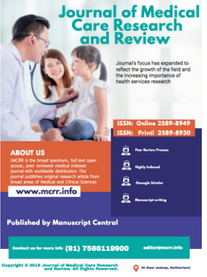Antibiotic Resistance Status of E.coli Isolated from Intensive Care Units of Adjara Hospitals
Abstract
Abstract
Background: Nosocomial infections are the group of infections that pose the greatest threat in terms of their cause- microorganisms, developing and spreading resistance to antibiotics (Keskin Seremet, et al., 2020). In addition, prolonged hospital stays, violation of sterilization and disinfection regulations in some cases, lack of professionalism, and shortage of knowledge among medical workers (Butsashvili et al., 2010) contribute to the spreading of these infections and the development of antibiotic resistance.
- coli is the leading infection in the urinary tract. This bacterium is the one that predominates in both nosocomial and community-acquired urinary tract infections (Alaniz et al., 2018) (Plate et al., 2019).
Objective: To identify E. coli in samples with suspected nosocomial infection, isolate pure culture, and determine antibiotic resistance in various biological fluids.
Materials and Methods: The study covered the following biological material obtained from the patients who spent 48 hours or more in the intensive care unit (total of 540): sputum, urine, material from the surface of the tip of venous and urinary catheters.
Various biological samples underwent a retrospective study. The bacteria were isolated and identified with the standard bacteriological methods, namely by sampling from the appropriate nutrient zones and then by separating the pure culture. Finally, cultures were identified using the API test, and sensitivity to antibiotics was determined by Kirby-Bauer diffusion and E-test. The double-disk method was applied to determine the producers of E. coli broad spectrum beta-lactamase (ESBL).
Result: The total of 540 samples was analyzed, out of which 236 were rejected as defective and 82 were gram-positive bacteria, and only 45 E. coli isolates were obtained from the remaining 158 samples. Thereof, 26 were resistant, and 23 were susceptible to antibiotics. Out of 158 samples, 89 were taken from sputum, –47 from urine, biological fluids-exudates from the tip of venous and urinary catheters. The highest degree of E. coli was found in sputum (56%) and urine (29%).
The analysis for antibiotic sensitivity in samples showed that the resistance rate of E. coli isolated in the intensive care units in Adjara was quite high. All isolates were 100% resistant to antibiotics such as CXM/Cefuroxime, CRO/Ceftriaxone, CAZ/Ceftazidime, CTX/Cefotaxime, and AMP/Ampicillin. The resistance rate of 70-80% to FEP/Cefepim, CIP/Ciprofloxacin, LVX/Levofloxacin, ATM/Aztreonam, AMC/Amoxicillin/clavulanic acid, and DOX/Doxycycline was recorded in E. coli isolates.
Conclusion: Only 3 antibiotics can be effective against Escherichia coli such as CST/Colistin, IPM/Imipenem, and MEM/Meropenem.
Full text article
References
2. Butsashvili, M., Kamkamidze, G., Umikashvili, L., Gvinjilia, L., Kankadze, K., & Berdzuli, N. (2010). Knowledge of health care-associated infections among Georgian obstetricians and gynecologists. The Journal of Infection in Developing Countries, 4(05), 329–333. https://doi.org/10.3855/jidc.526
3. Cambrea, S. (2015). Antibiotic susceptibility of Escherichia coli strains isolated in a pediatric population from South Eastern Romania. Journal of Pediatric Infectious Diseases, 09(03), 157–162. https://doi.org/10.3233/JPI-140430
4. Kandelaki, G., Butsashvili, M., Geleishvili, M., Avaliani, N., Macharashvili, N., Topuridze, M., Del Rio, C., Blumberg, H. M., & Tsertsvadze, T. (2011). Nosocomial Infections in Georgia; a retrospective study of microbiological data from four major tertiary care hospitals in Tbilisi, capital of Georgia. Infection Control and Hospital Epidemiology : The Official Journal of the Society of Hospital Epidemiologists of America, 32(9), 933–934. https://doi.org/10.1086/661788
5. Keski̇n Seremet, A., Kizilateş, F., Demi̇r Önder, K., & Öztoprak, N. (2020). Evaluation of Nosocomial Infections and Antimicrobial Resistance Profiles in the Intensive Care Units: Nine Years Experience. Yoğun Bakım Ünitesinde Nozokomiyal Enfeksiyonlar ve Antimikrobiyal Direnç Profillerinin Değerlendirilmesi: Dokuz Yıllık Deneyim., 8(4), 330–337. https://doi.org/10.14235/bas.galenos.2019.3448
6. *Kibret, M., & Abera, B. (2011). Antimicrobial susceptibility patterns of E. coli from clinical sources in northeast Ethiopia. African Health Sciences, 11(Suppl 1), S40–S45. https://www.ncbi.nlm.nih.gov/pmc/articles/PMC3220125/
7. (PDF) Identification of Acinetobacter spp. As determination of hospital infection causes and antibiotic resistance profile. (n.d.). ResearchGate. Retrieved September 29, 2020, from https://www.researchgate.net/publication/319333789_Identification_of_Acinetobacter_spp_As_determination_of_hospital_infection_causes_and_antibiotic_resistance_profile
8. Plate, A., Kronenberg, A., Risch, M., Mueller, Y., Di Gangi, S., Rosemann, T., & Senn, O. (2019). Active surveillance of antibiotic resistance patterns in urinary tract infections in primary care in Switzerland. Infection, 47(6), 1027–1035. https://doi.org/10.1007/s15010-019-01361-y
9. Tchouaket Nguemeleu, E., Boivin, S., Robins, S., Sia, D., Kilpatrick, K., Brousseau, S., Dubreuil, B., Larouche, C., & Parisien, N. (2020). Development and validation of a time and motion guide to assess the costs of prevention and control interventions for nosocomial infections: A Delphi method among experts. PloS One, 15(11), e0242212. https://doi.org/10.1371/journal.pone.0242212
10. Tian, L., Sun, Z., & Zhang, Z. (2018). Antimicrobial resistance of pathogens causing nosocomial bloodstream infection in Hubei Province, China, from 2014 to 2016: A multicenter retrospective study. BMC Public Health, 18(1), 1121. https://doi.org/10.1186/s12889-018-6013-5
11. Tolera, M., Abate, D., Dheresa, M., & Marami, D. (2018, December 4). Bacterial Nosocomial Infections and Antimicrobial Susceptibility Pattern among Patients Admitted at Hiwot Fana Specialized University Hospital, Eastern Ethiopia [Research Article]. Advances in Medicine; Hindawi. https://doi.org/10.1155/2018/2127814
12. Ullah, F., Malik, S., & Ahmed, J. (2009). Antibiotic susceptibility pattern and ESBL prevalence in nosocomial Escherichia coli from urinary tract infections in Pakistan. African Journal of Biotechnology, 8(16), Article 16. https://doi.org/10.4314/ajb.v8i16.62081

